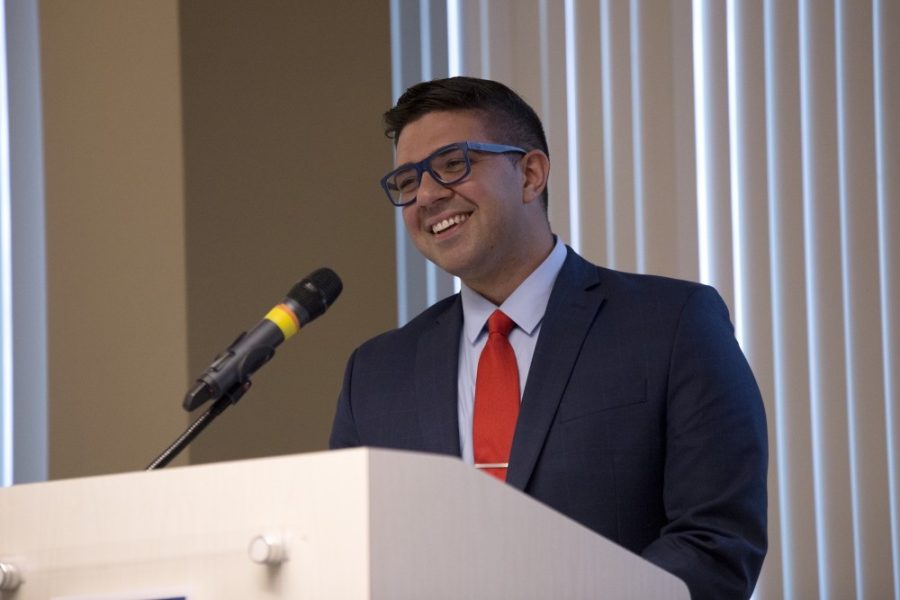The Associated Students of the University of Arizona Supreme Court granted a motion, filed by the elections commission, to dismiss the case of Saltalamacchia v. ASUA Elections Commission on Mar. 20.
Matt Lubisich, who had been initially disqualified for accruing 3-strikes against the ASUA elections code, is now officially the ASUA president-elect.
In a closed-door meeting, the Elections Commission’s moved to reverse one of the three strikes against Lubisich shortly after his initial disqualification. Stefano Saltalamacchia subsequently appealed the reversal to the ASUA Supreme Court.
Following the dismissal, the court canceled oral arguments scheduled to be held for the case on Mar. 20 at 7 p.m.
The court’s notice of ruling states their decision is final and that by dismissing the case, they affirm “the decision of the Elections Commission to overturn the strike against candidate Lubisich.”
Lubisich will remain ASUA president-elect and assume the presidency next semester after receiving the majority vote.
Saltalamacchia, Lubisich’s opponent in the presidential race, said he’ll apply for a position on Lubisich’s cabinet and that “there is a lot of work that needs to be done to ensure the success of our students” in a Facebook post Monday afternoon.
The ASUA cabinet is made up of a set of directors that report directly to the president and require a two-thirds senate approval.
According to the court’s rules of procedure, a majority of the justices must “agree that there is no genuine issue of material fact that requires the proceeding to move forward” in order to grant a motion to dismiss.
The court’s rules of procedure require motions to dismiss be filed no later than five business days after the close of pleadings.
Mar. 20 was the final day to submit a motion following the close of pleadings on Mar. 6.
RELATED: Saltalamacchia appeals decision to overturn Lubisich campaigning violations to ASUA Supreme Court
The court’s rules of procedure do not explicitly state whether Saltalamacchia has an opportunity to present an argument against the motion to dismiss.
Justice Kayla Bernays recused herself from the matter because she represented Saltalamacchia during a Supreme Court case last year.
At least three of the four remaining justices agreed the appeal filed by Saltalamacchia did not meet the court’s standards.
Before the decision was made public, Saltalamacchia met privately with Janis Gallego, ASUA Legal Services Advisor, to be informed of the decision. This is standard practice, according to Gallego.
The court will release a full opinion in the next 10 business days.
Saltalamacchia appealed to the court that the elections commission failed to consider potentially disqualifying evidence that would uphold Lubisich’s disqualification.
Shortly before the election, the commission reversed Lubisich’s third strike thereby making him president-elect.
Lubisich’s third strike was reversed on the grounds that Saltalamacchia’s team did not provide sufficient evidence, preferably a video, of Lubisich campaigning off campus during the general election.
According to Saltalamacchia, he forwarded an email from the management of The District, an off-campus housing site, which contends Lubisich did campaign on their premises.
Since Saltalamacchia did not formally submit a second complaint, the commission could not consider this evidence.
RELATED: Uncertainty looms following ASUA elections
Saltalamacchia also claimed to possess a video of Lubisich campaigning off campus. Since he did not fill out a complaint form within 48 hours of the filming of the video, the commission could not consider this evidence.
Had the video proven Saltalamacchia’s claim, the elections commission would have been forced to uphold Elections Commissioner Chloe Durand’s strike against Lubisich.
Lubisich did not receive the prior approval necessary to campaign off campus during the general election from the commission and therefore, Saltalamacchia would become president-elect.
Additionally, Saltalamacchia states the election commission failed to award Lubisich a fourth strike during the campaign after Saltalamacchia’s team submitted video evidence of Lubisich allegedly campaigning in the UA library.
The commission did not respond to this complaint.
Another complaint filed against Lubisich by the Saltalamacchia team alleged Lubisich included more than one candidate on a campaign poster.
According to Durand the social media post submitted as evidence included three individual posters and is not considered a slate. She said that the election code regulates physical and online campaign materials differently and that the sociala media post did not apply as it was posted on someone’s personal Facebook page.
It is unclear whether the person who created the post was affiliated with the campaigns of either candidate, or acting independently.
Until their full decision is released, it remains unclear if the Supreme Court factored these complaints into their decision to dismiss the case.









